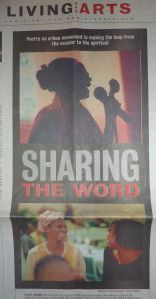They say getting into the media in a positive way is difficult. “If it bleeds, it leads.” Without a PR agent, I’ve been able to get at least one major feature for my events in print media every year consistently since 2005. (I took a break last year to produce a Broadway show for a local elementary school.)
Print media is still a very important media outlet, because more established sponsors and partners recognize it as unbiased media. Also, older patrons who are committed donors still look to newspapers for local news. Since advertising revenue determines paper space, a newspaper feature is a hot commodity. At the end of the day, no matter what other priorities exist for a newspaper, the newspaper is a storytelling outlet.
Knowing this, I always create “reporter bait”, which are press releases that fit what a newspaper needs. If I create the press release and it’s distributed as I recommend, the event will get press.
If you’ve got a worthy cause, you may not yet have the resources to pay someone like me. And as urgent as your work is to our community, the newspaper doesn’t need your story…unless you tell a story they need to write.
Here are some tips to get your very worthy cause some well-deserved press.
1. Know your newspaper.
It’s your local paper. Do you read it? Who is your favorite reporter? If you don’t know who is writing the stories, you won’t know who would be interested in your cause and your event. I was a featured story on WLRN’s ArtStreet because the producer and I communicated about their work. I mentioned the work I was doing with arts advocacy and it fit one of her upcoming shows. She worked with the newspaper– but also had a connection with a TV outlet.
Get to know the paper and its staff—and definitely honor their time tables.
2. Your press release should be a story, not just facts and names.
Yes, you know the fundraiser will help needy kids. The community will look better because of that beautiful mural. But a title, event description and a location isn’t enough to warrant space in print. You can find that out on Google. Tell them why did you get involved. I should know that you’re fundraising for the homeless shelter because of the little girl who walked into her own bedroom for the first time. Reporters and editors are storytellers too, and the best stories are the ones that remind us about the hope in the community.
You’re it—so tell the story we can’t wait to hear. This event and our cause struck home with the reporter, who had a personal affinity to the organization we were supporting.
3. Have high-quality photos.
Deadlines for news media are fast. They have to research the story quickly, and many times, run with the story within a day or two. Pictures are 90% more likely to catch a viewer’s attention than text alone. They can’t always come out to take pictures. Make their job easier. Provide pictures with at least 300 DPI—and forward it to your media contact in a separate email from the press release. The reporter thanked me for having photos ready for him for this spread.
4. Connect your event to a current event or a current issue.
What’s important in your community? Who are the major players or the major influences in your part of the world? Prior to the event featured in this article, there had been a lot of press about employment, career transition, and the need for companies in South Florida to retain their best talent. My perspective was that our best talent needed to take ownership of their careers, and build their own creative businesses.
What a refreshing angle to take on a hot topic. What new angle does your cause bring to light? Make sure it’s in your media.
5. To keep the media coming back, have a quality event.
So, yeah, you can tell a great story and get press. Eventually, the media will come out to see what you’ve got. I had spoken to the reporter for a few weeks prior to the event featured here, and she wouldn’t say whether or not they would cover the story. She came, introduced herself at the event, and she wasn’t disappointed. When I saw the spread, I celebrated with my collaborators.
Have a quality event that really serves the greater good. If you don’t deliver on what you promised in your press release, just burn your media contact list. In fact, don’t mention I gave you any advice either.
Try any one of these tips, and get yourself in the news. Feel free to let me know how it goes!
P.S. I hope I don’t need to say this. For the love of Pete, spell-check and grammar-verify your press release. Thanks!




